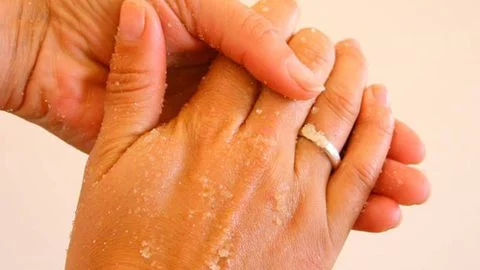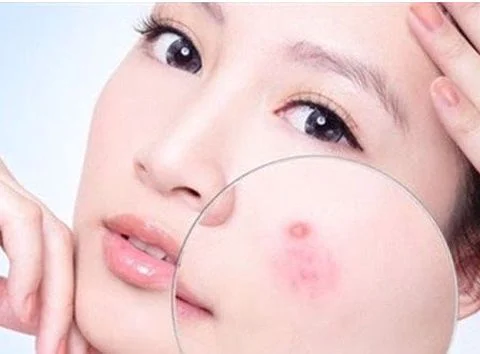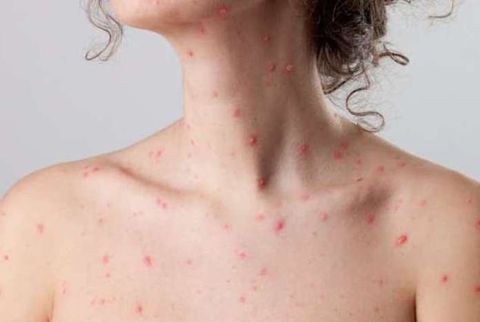Dry skin is a very common skin condition and can affect anyone, and is more common in older people. In most cases, arid skin does not cause serious health problems but can lead to some dermatological complications and be difficult to treat.
1. What is dry skin like?
Dry skin is a skin condition characterized by the lack of an adequate amount of water in the epidermal layer of the skin. Although arid skin tends to affect both sexes and people of all ages, older people are more susceptible to dry skin. Elderly skin tends to have less natural skin oils and lubricants than younger people.
Dry skin appears in areas such as the arms, hands and especially the feet. Environmental factors, such as humidity and temperature, have the most influence on the amount of water in the skin. Frequent hand washing also dehydrates and dries the skin. Dry skin can also be a side effect of some medications as well as a complication of some skin diseases.
The epidermis is usually composed of fats (lipids) and proteins. The lipid portion of the epidermis along with proteins helps prevent water loss in the skin. When the body lacks protein and/or lipids, the skin’s moisture content is not maintained properly and the skin becomes arid, it can also become more sensitive and prone to rashes and peeling.
Measures to prevent and treat arid skin are simple and effective. Basic steps to prevent arid skin include avoiding the use of concentrated soaps and harsh detergents.
Treatments often require people with dry skin to regularly use mild emollients and moisturizers. If left untreated, arid skin can lead to complications, including eczematous dermatitis, secondary bacterial infections, cellulitis, and skin discoloration. However, arid skin is usually mild and can be easily reversed.

2. Dry, acne-prone skin
Does dry skin cause acne, or is arid skin a result of acne treatment? People with naturally arid skin may experience acne, and acne treatment products can cause dryness and peeling. Most of us often see acne on oily skin, but when skin is arid, acne will also appear on the skin. Although it can occur at any age, acne and arid skin are most commonly found in adults.
Dry skin causes the skin to produce more oil, which can lead to clogged pores and more acne. Dry skin can be caused by genetics or by age, by acne treatment products, or by a combination of both. Moisturizers are a mainstay in any skin care routine, but some moisturizers for dry skin can be harshly irritating, or may contain ingredients that can clog pores, makes skin prone to acne. This is why it is important to be especially careful when choosing a moisturizer for acne-prone skin.
Dry skin and acne-prone skin are also associated with lower ceramide levels than normal skin. Ceramide is an active ingredient that plays a key role in the skin’s protective barrier, so a moisturizer with ceramide in it may also be beneficial for arid skin. Therefore, finding out the necessary information in a moisturizer when you are having problems with arid skin and acne is very important.

3. Dry, cracked skin
Painful, chapped, rough skin, often on the hands, face and especially the lips, due to arid skin. Chapping is caused by a lack or reduction in the natural oils that help the skin fight the condition. Dry, chapped skin tends to occur in cold weather, when oil-secreting glands secrete less oil, or after repeated bathing, washing, or wetting. Treatment for arid, chapped skin is often recommended by using lanolin foundation.
4. Dry, itchy skin
Dry, itchy skin is an uncomfortable feeling in the skin that causes the urge to scratch. Also known as pruritus, itchy skin can be caused or worsened by arid skin. Itchy skin is common in older people, as skin tends to become drier with age.
Itchy skin can appear on certain areas, such as on the arms or legs, or on the entire body. Besides, itchy skin can occur without any other noticeable changes in the skin, or it can be accompanied by the following signs:
- Red
- Bumps, spots, or blisters
- Dry, cracked skin
- Rough or scaly skin
Depending on the cause of the itching, the skin may appear normal, red, or rough or bumpy. Repeated scratching can cause raised areas of thickened skin that can bleed or become infected.
Using self-care measures such as daily moisturizing, using a gentle cleanser, and bathing in warm water will help make you more comfortable. Long-term symptom relief requires clearly identifying and treating the cause of itchy skin. Common treatments for arid, itchy skin include topical medications, moist bandages, and oral medications that relieve itching.

5. Dry skin lacks water
Dry, dehydrated skin is a skin condition that occurs when there is a lack of water in the skin. This can happen to anyone, regardless of skin type, and people with arid skin are more susceptible to dehydration. Dehydrated skin often darkens and shows signs of premature aging, such as surface wrinkles and loss of elasticity.
A typical way to tell if your skin is dehydrated is by doing a skin plumpness test:
- Pinch a small amount of skin on your cheek, belly, chest, or the back of your hand and hold for a few seconds.
- If it returns to normal, there may not be a lack of water.
- If it takes a few minutes to return to normal, the skin may be dehydrated.
In addition, with dry, dehydrated skin, you may notice some of the following signs:
- Dark circles under eyes
- Itchy
- Dark skin
- Wrinkle
6. Rough skin
Dry skin is a condition of abnormally raised skin. The nodules may be hard or soft and movable. Most lumpy skin conditions are benign, not cancerous. Skin tags are usually not dangerous and usually do not affect daily life. Possible causes of arid, rough skin include:
- Injury
- Acne
- Mole
- Warts
- Pockets of infection, such as abscesses and boils
- Cyst
- Bottle
- Allergic reactions, including hives
- Swollen lymph nodes
- Chicken pox

7. Itchy facial skin
An itchy face can be extremely uncomfortable, and it seems unclear what causes it. Common causes of arid, itchy facial skin include:
- Cold weather
- The air is dry
- Exposure to concentrated cleaning chemicals in soap or other products
- Wash your face many times
- Facial skin pH is unbalanced
- Unhealthy skin conditions, such as atopic dermatitis, seborrheic dermatitis and psoriasis
- Diabetes, hypothyroidism, liver disease
- Smoke
- Excessive exposure to sunlight
There are various remedies to treat dry, itchy facial skin. Choosing a treatment method depends on the cause of arid skin and the severity of the skin condition. Treatments also vary between different skin types, which can be normal, dry, oily or a combination.
There’s a lot you can do yourself to improve your skin, including using moisturizers and avoiding drying soaps. But sometimes arid skin occurs frequently or severely. In these cases, you need help from a skin specialist.
Sources: mayoclinic.org; medicinenet.com; cerave.com; healthline.com


